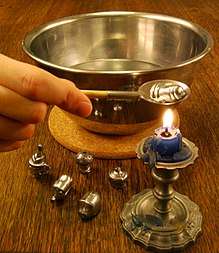Molybdomancy

Molybdomancy (from ancient Greek μόλυβδος - molybdos "lead"[1] + mancy, probably after Greek μολυβδομαντεία - molybdomanteia or French molybdomancie[2]) is a technique of divination using molten metal. Typically molten lead or tin is dropped into water.
Background
.jpg)
The method originates in ancient Greece[3] and it became a common New Year tradition in the Nordic countries and Germany (German: Bleigießen, "lead pouring"), Switzerland and Austria, and at Christmas (Christmas Eve) in the Czech Republic. Classically, tin is melted on a stove and poured into a bucket of cold water. The resulting shape is either directly interpreted as an omen for the future, or is rotated in a candlelight to create shadows, whose shapes are then interpreted.
Finland
In Finland, shops sell ladles and small bullions in the shape of a horseshoe for this express purpose. Originally made from tin, now they are made from cheaper low-melting alloys based on lead. The practice is known as uudenvuodentina.[3] The world's largest uudenvuodentina, 41 kilograms (90 lb), was cast by members of the Valko volunteer fire department in Loviisa, Finland, in New Year 2010.[4][5]
The shapes are often interpreted not only literally, but also symbolically: a bubbly surface refers to money, a fragile or broken shape misfortune. Ships refer to travelling, keys to career advancement, a basket to a good mushroom year, and a horse to a new car.[6]
Turkey
.png)
The tradition of molybdomancy is called "kurşun dökme" in Turkish (literally, "lead casting", "lead pouring") which is supposed to help with various spiritual problems, predict future, etc. The rituals vary, but they involve pouring molten lead into water.[7][8] Researchers from Ankara University performed a study of the effects of this tradition on the health of women. They reported risks of antimony poisoning and lead poisoning.[8]
A similar traditional practice is used in Bosnia and Herzegovina.[9]
See also
- Ceromancy – an easier method to achieve the same goals, using wax rather than metal.
Notes
- ↑ μόλυβδος, Henry George Liddell, Robert Scott, A Greek-English Lexicon, on Perseus
- ↑ Molybdomancy, Oxford Distionaries
- 1 2 "New Year's Tin". tin-mhjk.blogspot.com. Retrieved 28 September 2015.
- ↑ "Maailman suurin uudenvuoden tina valettiin Loviisassa". iltalehti.fi. Retrieved 28 September 2015.
- ↑ Valkon VPK valoi maailman suurimman uudenvuoden tinan 41 kg. YouTube. 1 January 2010. Retrieved 28 September 2015.
- ↑ http://www.rakentaja.fi/artikkelit/723/uudenvuoden_taikoja.htm
- ↑ pp. 233 ff., Healing Secular Life: Loss and Devotion in Modern Turkey, Christopher Dole, University of Pennsylvania Press, 2012, ISBN 0812206355
- 1 2 "Kurşun döktürmenin inanılmaz zararı", Milliyet (retrieved December 21, 2017)
- ↑ "Traditional Medicine in the Pristine Village of Prokoško Lake on Vranica Mountain, Bosnia and Herzegovina", Broza Šarić-Kundalić et al., Scientia Pharmaceutica 78, #2 (2010 June 30), pp. 275–290, doi:10.3797/scipharm.1003-06.
References
External links
| Wikimedia Commons has media related to Molybdomancy. |